
Everything You Ever Wanted to Know About Algae in a Fishtank
One of the greatest concerns of all aquatic plant enthusiasts is algae prevention. Once algae get a foothold in a planted aquarium it can be hard to bring it under control. We’ll take a look at the different kinds of algae that make trouble in planted tanks, what stimulates their growth and how to keep algae under control. But first let’s compare aquatic plants to algae so we can understand the similarities and differences.
At the end of this article is an Algae Clean-up Crew list.
Plants vs. Algae
It is important to understand that both aquatic plants and algae need light and nutrients to survive. When you see a beautiful planted aquarium with thriving aquatic plants and clear water understand that the tank is not algae-free. Every surface including plant leaves has a thin coating of algae, bacteria, worms and other microscopic life. The clear-looking water is actually teeming with algae cells. In this situation algae growth is nicely balanced with plant growth. It is not possible or even desirable to eliminate all algae growth in a planted aquarium.
Algae are an important part of the food chain in an aquarium and are also helpful in maintaining a healthy biological balance that ultimately results in a beautiful planted aquarium. There is also evidence that actively growing aquatic plants release compounds that inhibit algae growth (Allelopathy), helping to maintain a proper ecological balance. There is also a natural order of appearance of certain kinds of algae as a new aquarium ages. Under normal circumstances different types of algae will appear and disappear as the aquarium matures and a balance of algae species takes hold.
The key to minimizing algae growth is to create an environment that favors plant growth over algae growth. In general this means maintaining a steady carbon dioxide level and keeping the nutrients under tight control so plants thrive and algae starves.
Black Brush Algae (BBA)
One of the toughest algae to control, Audouinella is actually a type of filamentous red algae. It attaches to the edges of plant leaves, bog wood and aquarium hardware, forming dark, velvety patches. BBA will attach to filter outlets near fast-moving water or in poor water circulation areas of the tank. This algae will grow in dim and brightly-lit conditions. It is difficult to remove from plants and surfaces even when it is dead.
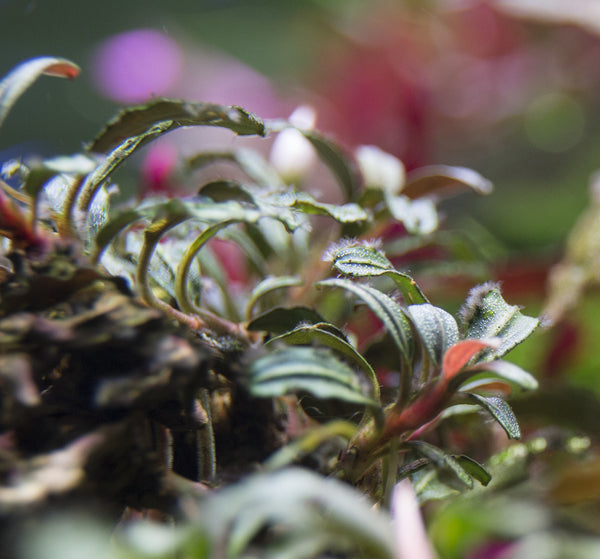
- Trim off infested leaves when algae first appears
- Take steps to maximize plant growth which inhibits the algae
- Treat the water with higher doses of liquid carbon (glutaraldehyde-based) additives
- Provide a stable CO2 level so plants grow at a steady rate and out-compete the BBA
- Stock the aquarium with Siamese algae eaters
Blue-Green Algae
There are many species of blue-green algae (BGA) that can appear in your aquarium. Anabaena, Aphanizomenon, and Microcystis are common types. BGA is technically a photosynthetic bacteria called Cyanobacteria. It thrives in nutrient-rich water and can live in low-light conditions. BGA may appear in newly set-up tanks during the break-in period or later in dirty, poorly maintained aquariums. Normally it fades away as the new aquarium matures.

- BGA can appear in newly set-up tanks
- Siphon out the algae while making water changes (approx. 30%)
- Increase water circulation to prevent stagnant areas
- Increase nitrate to about 20 ppm if using the Estimative Index method
- Keep the gravel bed free of decaying sludge and organic matter
- BGA should disappear in a clean, healthy, well-lit planted aquarium
- If BGA persists, use an anti-bacterial medication that contains erythromycin
Blanket Weed (Cladophora)
There are many species of Cladophora that are grouped into the blanket weed category. Blanket weed is a branching green filamentous algae. The algae can form free-floating mats or attach to bog wood, gravel and plants. It thrives when nutrients in the aquarium water are elevated. Cladophora gets its carbon from either bicarbonate (alkalinity) or CO2 and can thrive even if CO2 is low. Higher doses of glutaraldehyde-based carbon supplements can help control blanket weed.

Prevention & Control
- Make sure new plants are free of blanket weed
- Maintain proper nutrient and CO2 balance to stimulate plant growth
- Manually remove clumps of blanket weed
- Amano shrimp and Cherry shrimp will graze on blanket weed
Diatoms – Brown algae
Diatoms are single celled algae that can appear as a brown coating on aquarium glass, gravel and plant leaves. There are many species. Diatoms form a silica cell wall called a frustule. The silica is extracted from the water to form the hard “skeleton”. Diatoms are usually one of the first types of algae to grow in a new aquarium, appearing on the glass and gravel. As the tank matures diatom growth usually declines and becomes unnoticeable. Diatoms may coat poorly growing plants and dying leaves. If your tap water is high in silicates it may cause excess diatom growth.

Prevention & Control
- Diatoms normally disappear over time
- Wipe the aquarium glass with a soft cloth
- Add a school of Otocinclus
Green Dust Algae
This algae looks like a fine green layer of algae on glass and bogwood. It is unsightly and requires frequent scraping to keep the glass clean. The cause is a simple imbalance in the competition between aquatic plants and algae for nutrients and light. A lack of a single nutrient, like nitrate or phosphate, can inhibit plant growth and tip the scales toward green dust algae. Too long of a photoperiod can also stimulate this kind of algae.
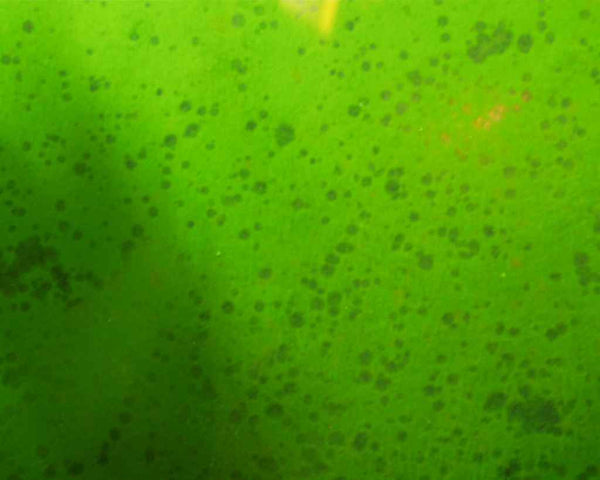
Prevention & Control
- Keep the lights on for no longer than 10 hours
- Use a balanced fertilizer regime
- Scrape the glass with a razor or algae scraper
- Maintain a steady CO2 level especially in a high-light aquarium
- Add a Bristlenose pleco or school of Otocinclus
Green spot algae
Green spot algae form small colonies of single-cell algae growing on plant leaves and aquarium glass. The green spots can be difficult to scrape off the glass. The colonies of green algae can appear on the leaves of slow-growing aquatic plants. Slow plant growth and having the lights on too long can allow green spot algae to take control.

Prevention & Control
- Trim plant leaves if they start to decline in health
- Encourage plant growth by maintaining a stable CO2 level
- Increase phosphate level (Estimative Index method) if necessary to stimulate plant growth
- Add a Bristlenose pleco or school of Otocinclus
Green Water Algae Blooms
Green water is caused by explosive growth of single-celled green planktonic algae. The algae cells quickly reproduce until the water turns green. Eventually the algae will die back as nutrients become depleted. A sudden die-off can cause a low oxygen condition that results in fish loss.
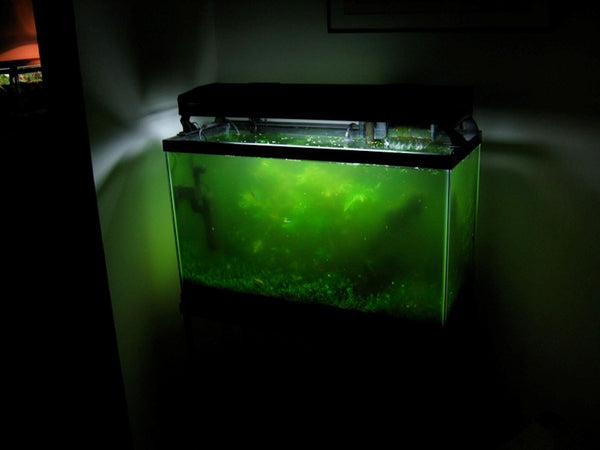
Prevention & Control
- Green water blooms may disappear after one to two weeks
- Keep the lights on for no longer than 10 hours
- Turn off the aquarium light for a few days to trigger an algae decline
- A UV light will kill the algae and prevent its return
Hair Algae
Hair algae are green filamentous algae that grow in long strands. Hair algae can clog filter intakes and become entangled in aquatic plants. Like blanket weed, hair algae thrives when it has adequate nutrients and aquatic plant growth is slow.

Prevention & Control
- Keep the lights on for no longer than 10 hours
- Physically remove or siphon out the algae strands
- Flagfish or Mollies will eat hair algae
- Cherry and Amano shrimp will graze on hair algae
Staghorn algae
Compsopogon is a red algae that appears green, white or gray in color. It has a branching growth pattern that resembles an antler. Staghorn algae can attach to equipment and plant leaves. It is believed that a nutrient imbalance or low CO2 allows it to thrive.
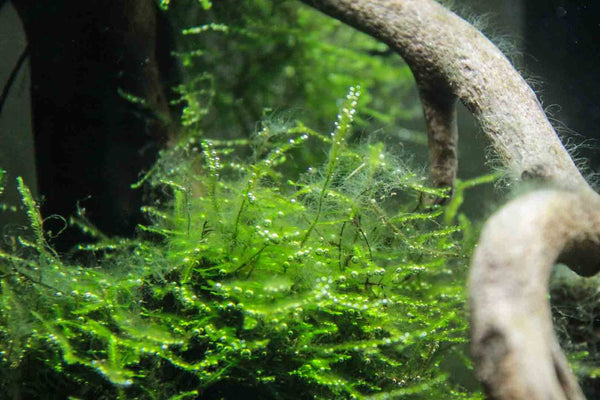
Prevention & Control
- Manually remove the algae from plants and equipment
- Maintain proper nutrient balance
- Aquarists report success with Siamese algae eaters
Fuzz Algae
Filamentous algae species look like fuzzy green strands. Fuzz algae can appear when nutrients are high and plants growth is low due to CO2 limitation. Fuzz algae can also grow when there is a nutrient shortage and aquatic plant growth is inhibited.

Prevention & Control
- Manually remove the algae
- Maintain proper nutrient and CO2 balance
- Treat the water with higher doses of liquid carbon (glutaraldehyde-based) additives
- Add Amano shrimp, Cherry shrimp, Rosy barbs or Mollies
Algae Clean-up Crew List
These guys may be a temporary fix to some of your existing algae problems. However, note that you should never rely completely on these critters to control your algae. The key to beating algae is a balance of proper water parameters, light, and CO2!
Otocinclus
- Diatoms
- Green dust algae
- Green spot algae
- Hair algae
Siamese algae eater
- Black brush algae
Nerite snails
- Diatoms
- Green dust algae
- Green spot algae
Amano shrimp
- Hair algae
- Blanket weed algae
- Fuzz algae
Flag fish
- Black beard algae
- Hair algae
- Blanket weed
Mollies
- Hair algae
- Blanket weed algae
- Fuzz algae
Rosy barbs
- Black beard algae
- Hair algae
- Blanket weed algae
- Fuzz algae
Bristlenose pleco
- Diatoms
- Green dust algae
- Green spot algae
Tell us - Was this article helpful? Please leave a comment below!
If you have any questions regarding this article, please DM us on Instagram, Facebook, or email support@buceplant.com so we can assist you - @buceplant


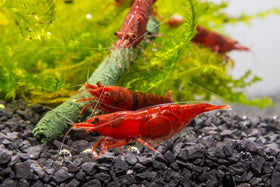
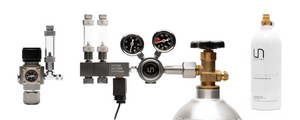

Comments
Leave a comment